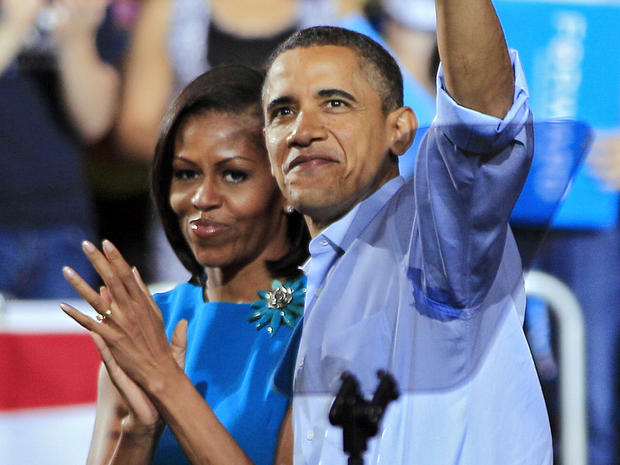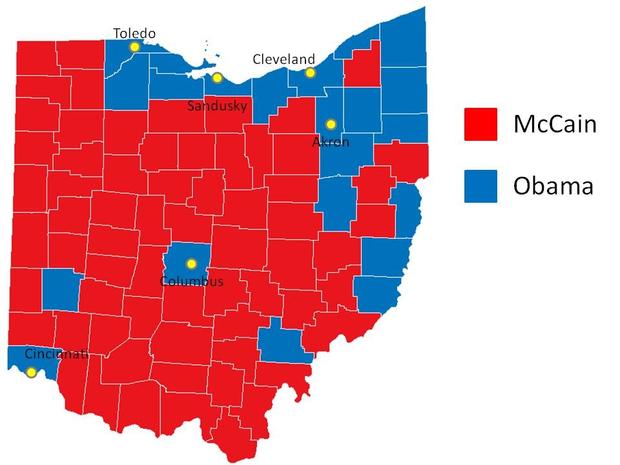Obama's bus tour: Looking for blue collar votes in critical blue counties
(CBS News) President Obama's two-day bus trip starting Thursday through Northern Ohio and Western Pennsylvania is a trip largely through places he won before and where he'll need to succeed again. This is no swing-county tour; this is a lot of need-to-have, not nice-to-have territory for any Democrat hoping to win these states.
And he needs solid margins here, too, which means generating excitement (i.e., turnout) can be as important as persuasion. Any substantial loss of voters along this route either to Mitt Romney - or to lower turnout - would deal a blow to his chances.
Beyond the vote math, these areas more broadly signal both opportunity and peril for Mr. Obama with key segments of voters, particularly in manufacturing and blue-collar industries. There are plenty of ties to the auto business in these areas as well as to new industries, which offers him a chance to trumpet his policies. But it also means these are a lot of the people who've been especially hard hit by the economy's downturn -- and with whom he's had trouble so far.
Visiting Toledo, in the northwestern part of the state, brings him to a fairly large county (Lucas) that he took by a two to one margin in 2008, netting him a quarter of his whole statewide margin. It has ties to the auto industry, and here he can neither afford a lighter turnout nor the loss of a large percent of that margin. Next is Sandusky, Ohio, in Erie county. It has fewer voters than Toledo, but it's an area he won in 2008, another important manufacturing center, and another possible indicator of his fortunes - plus, it keeps him the media market, which all told holds almost three-quarters of a million voters in its counties. (In trips like this it's often about reaching out in the media market and securing a spot on the local airwaves as much as the voters the campaign sees in person.)
In Parma, outside Cleveland, we see again the importance of rallying the voters he won last time. A fairly large city in itself, it's part of Cuyahoga county - Cleveland - which forms part of the bedrock of any Democratic formula to win the state. In 2008, Obama won Cuyahoga county with a whopping 69 percent of the vote. Well over 650,000 votes were cast there four years ago, which is roughly the number of votes he won the state by last time around.
A quick look at the map below demonstrates just how important northern and northeastern Ohio are to the president. Counties marked in blue, notably those in this densely populated area, helped propel him to the win four years ago; they are also the area of this week's trip. There are about three million voters in the Cleveland-Akron market.
Akron, moving southeast of Cleveland to Summit county, is especially worth watching. It's part of an area (along with nearby Canton in Stark county, which was a tighter Obama win last time) that has looked to transition from older manufacturing to more high-tech industries, and may also be another indicator of how well the president can do with working-class and blue-collar voters.
In 2008, white voters without college degrees were half the Ohio electorate. Mr. Obama lost Ohioans of this group in 2008 to John McCain - but for the president, it isn't about winning this group, it will be a question of keeping the "gap" at least somewhat smaller assuming he loses them. In a Quinnipiac poll of Ohio last month, the race was basically tied statewide, but Mr. Obama was trailing Romney by well into double-digits among that group. Mr. Obama's deficit was ten points four years ago. A key indicator to watch, come the fall, will be if he trails by a much wider margin.
(As an aside, it's also interesting is that in the GOP primary, among Republicans, Romney lost this group to Rick Santorum. Watch too as we head into fall for signs of whether these voters aren't enthralled with either candidate.)
The president has been leading in polls in Pennsylvania, bolstered in part by strong support from the large number of Democrats in the state and a slight lead with independents. But there are warning signs for him. In a recent Quinnipiac poll, voters there gave Romney the edge on jobs and the economy. Less than half were satisfied with how things are going in the state, including those in the western parts and Pittsburgh area.
In Pittsburgh, where Mr. Obama wraps up his trip Friday, once again it's not necessarily about affecting a swing, it's about keeping his voters in the fold. In 2008 as he won the state comfortably, Pittsburgh's Alleghany county alone contributed about one-sixth, or 100,000, votes to his statewide margin. If this year we see a closer election, its impact becomes magnified.
More broadly, the Pittsburgh and western part of the state encompass almost one-fourth of the statewide vote. Mr. Obama won the region over McCain in 2008 (if we count the region from Johnstown west) but if Romney is going to win statewide, then this region, as well as in those outlying Philly suburbs, are likely the places he can and will need to make inroads. (He'll likely win the Republican-leaning the central part.) In the smaller electorate of the midterms, the western part of the state went Republican - indicating there are plenty of voters in play her, as well. Supposing, hypothetically, the race this year looks more like it did in 2004 and Mr. Obama doesn't perform quite as well back east in the suburbs of Philly, the other bookend of the Democratic formula for the state, than only increases the importance of Pittsburgh.
In all, battling through this part of the country is nothing new for an Obama campaign. Recall that all the way back to the 2008 primaries, a lot of this region had first backed Hillary Clinton; one of the key tests in November four years ago was whether Mr. Obama could win over these voters. For the most part, he did. But he'll have to work to hold them again.


